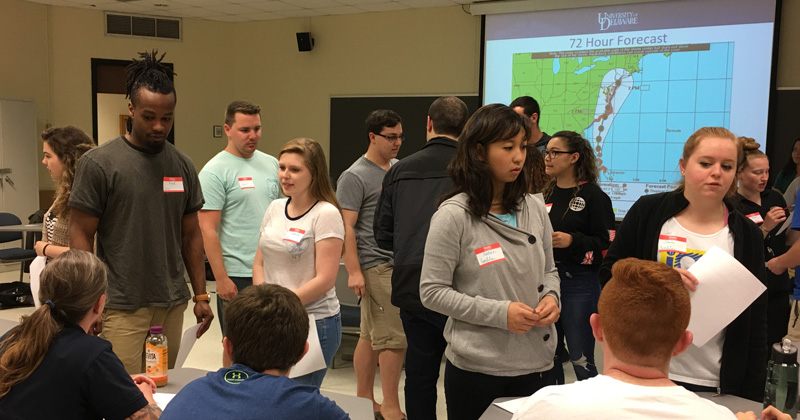


Preparing for disaster
May 29, 2018
Students design, carry out classroom emergency exercise
A good classroom activity is one that helps students focus what they’ve learned, sharpen their thinking and bring imaginative approaches to problem-solving.
Recently, two groups of students—graduate and undergraduate—at the University of Delaware pulled together their knowledge of hazards and disasters for just such an activity. The result was a unique “cross-over event,” a disaster management exercise centered on the scenario of a major hurricane striking the UD campus.
Tricia Wachtendorf, professor of sociology and criminal justice, and James Kendra, professor of public policy and administration, teamed up to offer this opportunity for their students. The professors are also co-directors of UD’s Disaster Research Center.
Undergraduates in Wachtendorf’s “Disaster and Society” course spent this spring semester discussing such topics as the social foundations of disasters, warnings and evacuations, and the social capital and influx of volunteers and donations in the post-disaster environment.
Meanwhile, graduate students in Kendra’s “Issues in Disaster Response” course focused in-depth on typical challenges that arise in disaster. In an innovative variation, the graduate students designed a table-top exercise and guided the undergraduates as they tackled fast-paced disaster challenges.
The exercise combined elements of hurricanes that Delaware has already experienced, Irene and Sandy, and it featured challenges that arise in disaster scenarios, such as students evacuating without necessary medications. Other potential problems included loss of cell phone service and water and electricity outages.
Many of the graduate students will be going on to careers in emergency management, Kendra said, and “the exercise encouraged them to put together what they know about disasters and to design an exercise.” Good exercise design is itself an important emergency management skill, he said.
For the undergraduate students, the exercise allowed them to apply what they had learned in class to actual disaster scenarios. Although a fictitious event, the exercise incorporated tough disaster management problems that have occurred in real situations.
“Going into it, I thought the exercise was going to be informative, but I didn’t anticipate how chaotic it would be,” said Samantha Miles, a junior political science major. “It was a good lesson in how applying concepts from the classroom can feel so different when actually executing them.”
Undergraduate students gain a lot from this kind of experience, according to Wachtendorf.
“They start to see where the concepts they learned about in class actually can help guide their decisions,” she said. “And they begin to realize how very challenging it is for emergency managers to deal with these emerging issues.”
Roles for the scenario were drawn from the University’s existing disaster plan, with groups of students in such roles as public safety, residence life and University president.
As the hurricane advanced, students received “injects,” which are problems that require some action to solve. Usually, that action requires close coordination with other roles. Almost always, the decision requires balancing time and resources.
Eileen Young, a master’s degree student in disaster science and management who was one of the exercise developers, said the experience helped her not only to better understand the issues the class covered in the readings, but also to think about how to create an experience for the undergraduate students to learn those lessons as well.
“We got to see what the undergraduates had learned over the course of the semester and watch them use that knowledge to assess the situations they encountered and to reason through problems,” Young said. “More than that, though, it was a lot of fun.”
Contact Us
Have a UDaily story idea?
Contact us at ocm@udel.edu
Members of the press
Contact us at 302-831-NEWS or visit the Media Relations website

